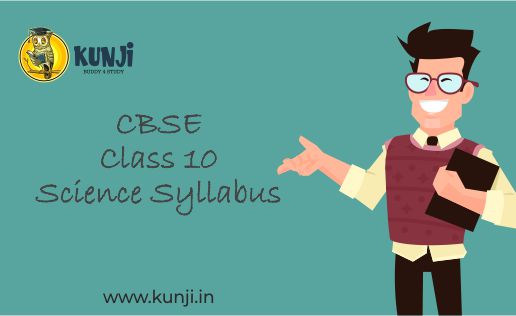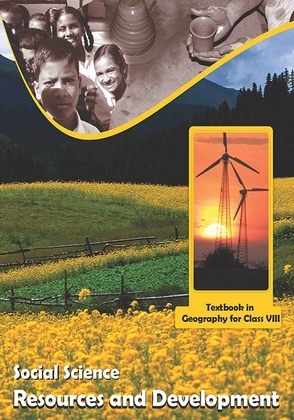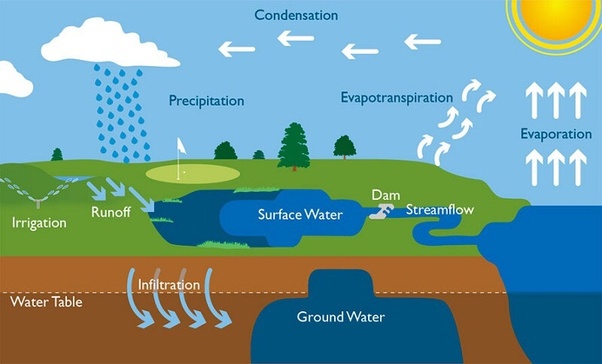Syllabus for CBSE Class 10 Science for 2020-21 Session
CBSE Class 10 Science Syllabus – This syllabus is an important tool for effective learning. It is also helpful to create the right preparation structure for all the internal examinations and the annual board examination as well. The CBSE Class 10 Science syllabus provides details of the course structure along with topics prescribed for the academic session 2020-2021.
Also See: CBSE Class 10 NCERT Solutions
The Main contents of CBSE Class 10 Science syllabus 2020-21 are:
- Unit-wise weightage
- Topics and subtopics to be prepared form each unit
- List of experiments to be performed for practical work
- Question paper design for the annual board examination
- Components of Internal Assessment
- Prescribed books
Students are suggested to make preparations according to the details and contents mentioned in the CBSE syllabus.
Below is the complete syllabus for CBSE Class 10 Science:
| CBSE Class 10 Science Unit Wise Weightage | ||
| Unit | Title | Weightage |
| 1 | Chemical Substances-Nature and Behaviour | 25 |
| 2 | World of Living | 23 |
| 3 | Natural Phenomena | 12 |
| 4 | Effects of Current | 13 |
| 5 | Natural Resources | 07 |
| Total Marks | 80 | |
| Internal Assessment | 20 | |
| Grand Total | 100 | |
CBSE Class 10 Science question paper 2020 will have a different format as compared to the previous year. The science question paper will consist of a total of 30 questions out of which the first 14 questions will be of objective type questions. These objective type questions will be asked in different formats like MCQ, VSA type, and assertion-reason type questions. Each question will carry 1 mark.
The detail of CBSE Class 10 Science Syllabus is provided below:
Theme: Materials
Unit I: Chemical Substances-Nature and Behaviour (55 Periods)
Chemical reactions: Chemical equation, Balanced chemical equation, the implication of a balanced chemical equation, types of chemical reactions: Combination, decomposition, displacement, double displacement, precipitation, neutralization, oxidation, and reduction.
Acids, bases and salts: Their definitions in terms of furnishing of H+ and OH- ions, General properties, examples, and uses, the concept of pH scale (Definition relating to logarithm not required), the importance of pH in everyday life; preparation and uses of Sodium Hydroxide, Bleaching powder, Baking soda, Washing soda and Plaster of Paris.
Metals and nonmetals: Properties of metals and non-metals; Reactivity series; Formation and properties of ionic compounds; Basic metallurgical processes; Corrosion and its prevention.
Carbon compounds: Covalent bonding in carbon compounds. Versatile nature of carbon. Homologous series. Nomenclature of carbon compounds containing functional groups (halogens, alcohol, ketones, aldehydes, alkanes, and alkynes), the difference between saturated hydrocarbons and unsaturated hydrocarbons. Chemical properties of carbon compounds (combustion, oxidation, addition, and substitution reaction). Ethanol and Ethanoic acid (only properties and uses), soaps, and detergents.
Periodic classification of elements: Need for classification, Early attempts at classification of elements (Dobereiner’s Triads, Newland’s Law of Octaves, Mendeleev’s Periodic Table), Modern periodic table, gradation in properties, valency, atomic number, metallic and non-metallic properties.
Theme: The World of the Living
Unit II: World of Living (50 Periods)
Life processes: ‘Living Being’. The basic concept of nutrition, respiration, transport, and excretion in plants and animals.
Control and co-ordination in animals and plants: Tropic of movements in plants; Introduction of plant hormones; Control and co-ordination in animals; Nervous system; Voluntary, involuntary and reflex action; Chemical co-ordination: animal hormones.
Reproduction: Reproduction in animals and plants (asexual and sexual) reproductive health-need and methods of family planning. Safe sex vs HIV / AIDS. Childbearing and women’s health.
Heredity and Evolution: Heredity; Mendel’s contribution – Laws for inheritance of traits: Sex determination: brief introduction; Basic concepts of evolution.
Theme: Natural Phenomena
Unit III: Natural Phenomena (23 Periods)
Reflection of light by curved surfaces; Images formed by spherical mirrors, center of curvature, principal axis, principal focus, focal length, mirror formula (Derivation not required), magnification.
Refraction; Laws of refraction, refractive index.
Refraction of light by the spherical lens; Image formed by spherical lenses; Lens formula (Derivation not required); Magnification. Power of a lens.
The functioning of a lens in the human eye, defects of vision and their corrections, applications of spherical mirrors and lenses.
Refraction of light through a prism, dispersion of light, scattering of light, applications in daily life.
Theme: How Things Work
Unit IV: Effects of Current (32 Periods)
Electric current, potential difference, and electric current. Ohm’s law; Resistance, resistivity, Factors on which the resistance of a conductor depends. Series combination of resistors, the parallel combination of resistors and its applications in daily life. Heating effect of electric current and its applications in daily life. Electric power, Interrelation between P, V, I and R.
Magnetic effects of current: Magnetic field, field lines, field due to a current-carrying conductor, field due to current carrying coil or solenoid; Force on the current-carrying conductor, Fleming’s Left-Hand Rule, Electric Motor, Electromagnetic induction. The induced potential difference, Induced current. Fleming’s Right Hand Rule, Electric Generator, Direct Current. Alternating current: frequency of AC. Advantage of AC over DC. Domestic electric circuits.
Theme: Natural Resources
Unit V: Natural Resources (20 Periods)
Sources of energy: Different forms of energy, conventional and non-conventional sources of energy: Fossil fuels, solar energy; biogas; wind, water, and tidal energy; Nuclear energy. Renewable versus non-renewable sources of Energy.
Our environment: Eco-system, Environmental problems, Ozone depletion, waste production, and their solutions. Biodegradable and non-biodegradable substances.
Management of natural resources: Conservation and judicious use of natural resources. Forest and wildlife; Coal and Petroleum conservation. Examples of people’s participation in the conservation of natural resources. Big dams: advantages and limitations; alternatives, if any. Water harvesting. Sustainability of natural resources.
PRACTICALS
Practicals should be conducted alongside the concepts taught in theory classes.
List of Experiments:
1. A. Finding the pH of the following samples by using pH paper / universal indicator: (Unit – I)
(i) Dilute Hydrochloric Acid
(ii) Dilute NaOH solution
(iii) Dilute Ethanoic Acid Solution
(iv) Lemon juice
(v) Water
(vi) Dilute Hydrogen Carbonate solution
B. Studying the properties of acids and bases (HCl & NaOH) by their reaction with: (Unit – I)
(a) Litmus solution (Blue/Red)
(b) Zinc metal
(c) Solid sodium carbonate
2. Performing and observing the following reactions and classifying them into (Unit – I)
(a) Combination reaction
(b) Decomposition reaction
(c) Displacement reaction
(d) Double displacement reaction
(i) The action of water on quick lime
(ii) The action of heat on ferrous sulphate crystals
(iii) Iron nails kept in copper sulphate solution
(iv) The reaction between sodium sulphate and barium chloride solutions
3. Observing the action of Zn, Fe, Cu, and Al metals on the following salt solutions: (Unit – I)
(a) ZnSO4 (aq)
(b) FeSO4 (aq)
(c) CuSO4 (aq)
(d) Al2(SO4)3 (aq)
Arranging Zn, Fe, Cu and Al (metals) in the decreasing order of reactivity based on the above result.
4. Studying the dependence of potential difference (V) across a resistor on the current (I) passing through it and determine its resistance. Also plotting a graph between V and I. (Unit – IV)
5. Determination of the equivalent resistance of two resistors when connected in series and parallel. (Unit – IV)
6. Preparing a temporary mount of a leaf peel to show stomata. (Unit – IV)
7. Experimentally show that carbon dioxide is given out during respiration. (Unit – II)
8. Study of the following properties of acetic acid (ethanoic acid): (Unit – I)
(i) odor
(ii) solubility in water
(iii) effect on litmus
(iv) reaction with sodium Hydrogen Carbonate
9. Study of the comparative cleaning capacity of a sample of soap in soft and hard water. (Unit – I)
10. Determination of the focal length of (Unit – III)
(i) Concave mirror
(ii) Convex lens
by obtaining the image of a distant object.
11. Tracing the path of a ray of light passing through a rectangular glass slab for different angles of incidence. Measure the angle of incidence, angle of refraction, angle of emergence and interpret the result. (Unit – III)
12. Studying (a) binary fission in Amoeba, and (b) budding in yeast and Hydra with the help of prepared slides. (Unit – II)
13. Tracing the path of the rays of light through a glass prism. (Unit – III)
14. Finding the image distance for varying object distances in case of a convex lens and drawing corresponding ray diagrams to show the nature of the image formed. (Unit – III)
15. Identification of the different parts of an embryo of a dicot seed (Pea, gram or red kidney bean). (Unit – II)
Assessment Areas (Theory) 2020-21
(Class X)
Science (086)
Time: 3 hrs. Maximum Marks: 80 Marks
| Competencies | |
| Demonstrate Knowledge and Understanding | 46% |
| Application of Knowledge/Concepts | 22% |
| Analyze, Evaluate and Create | 32% |
Note:
- Typology of Questions: VSA including objective type questions, Assertion – Reasoning type questions; SA; LA; Source-based/ Case-based/ Passage-based/ Integrated assessment questions.
- An internal choice of approximately 33% would be provided.
2) Internal Assessment: 20 Marks
- Periodic Assessment – 05 marks + 05 marks
- Subject Enrichment (Practical Work) – 05 marks
- Portfolio – 05 marks
PRESCRIBED BOOKS
| 1. Science – Textbook for Class X – NCERT Publication |
| 2. Assessment of Practical Skills in Science – Class X – CBSE Publication |
| 3. Laboratory Manual – Science – Class X, NCERT Publication |
| 4. Exemplar Problems Class X – NCERT Publication |
Also See:
- CBSE Class 10 Japanese Syllabus for 2020-21
- CBSE Class 10 Maths Syllabus for 2020-21
- CBSE Class 10 Hindi Syllabus for 2020-21
- CBSE Class 10 Home Science Syllabus for 2020-21
- CBSE Class 10 German Syllabus for 2020-2021
- CBSE Class 10 French Syllabus for 2020-2021
- CBSE Class 10 English Syllabus for 2020-2021
- CBSE Class 10 Science Syllabus for 2020-21





